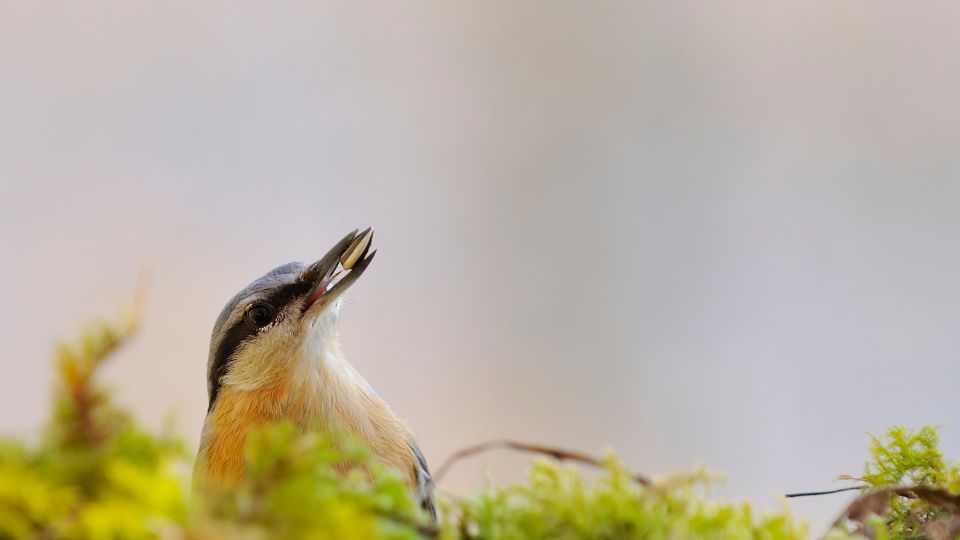The Red-Breasted Nuthatch (Sitta canadensis) are common backyard songbirds that often mate for life. Their birdcalls sound like nasally and dense yanks, trills, and they also have a distinct wha-wha-wha call that is one of the first to break through the silence in winter.
Ever wonder who makes that nasally wha-wha-wha outside your window every morning? Odds are, it’s a nuthatch! What’s interesting about the nuthatch call is that you can learn a lot about their mood just by observing the pitch and frequency of their unique calls.
Overall, their birdsongs sound a tad nasally and use a series of yanks, trills, and wha-wha-wha calls to communicate with each other. Their bird calls are slightly similar to the tempo of chickadees, so you have to listen very carefully to pick up the versatile call of a nuthatch song. Let’s dive into the various calls of the nuthatch, how to listen for them, and what they mean.
What do Nuthatches Sound Like
The nuthatch has a call that is often a variation of a wha-wha-wha call. Their bird sounds are very similar, but an increase in tempo and pitch indicate different things. During mating season, the wha-wha-wha call sounds much different than their bird calls at other points of the season. If you hear a Nuthatch chattering away in your yard, here’s a quick breakdown of what those calls mean.
The Nuthatch Mating Call
The mating call is often heard in the spring and is one of their most beautiful bird calls. Their standard wha-wha-wha call picks up in pitch, and frequency allowing male nuthatches to attract female companions. It’s important to note that the call sounds slightly similar to the mating call of the chickadee, but has a more nasally sound that’s faster and of a higher pitch.
The male nuthatch doesn’t waste any time when it comes to mating. The breeding season of these Passeriformes starts in the late winter. During late winter and into the spring, the white breasted nuthatch call is accompanied by a song and courtship display. It cocks its head and wings at a strange angle and sways back and forth on a branch.
Friendly Contact Calls
Both male and female nuthatches communicate with a quick yank-yank call. The yank-yank call is the familiar song of the nuthatch, often heard year-round. Variations of this unique trill indicate anything from simple communication to warning nearby songbirds around a bird feeder or nest of predators (such as crows).
What’s amazing about nuthatches is that these pairs can and will mate for life (while some still like to play the field). To communicate with each other as they raise their brood or build a nest, the bird calls between nuthatches are much different than their mating calls.
When nest building, the yank-yank call speeds up in intensity to the point that it sounds more like a trill. Bird watchers have also spotted them singing their slowed-down yank-yank trill while in flight.
Warning Calls
When the nuthatch is agitated, feeling territorial, or warning surrounding birds of a predator, their bird call sounds very similar to that of a wren. They emit a phew-like call that’s quick to sound like a trill and flap their wings furiously. Nuthatch warning calls are used by other neighboring nuthatches and songbirds to determine the level of danger in the area.

Foraging for Food
When scouting for food at backyard bird feeders, nuthatches gently communicate to each other with a very soft “yink” call. This birdcall is common in male and female nuthatch as they gleefully peck away at backyard offerings. If you want to invite nuthatches to your backyard, provide sunflower seeds, suet, and mealworms in your backyard feeder.
The diet of the nuthatch is very similar to that of a woodpecker, black-capped chickadee, warbler, oriole, or tufted titmouse. These songbirds have identical diets and often find food in tree trunks, with cheerful chirps as they peck away for food.
How to Easily Hear the Nuthatch Call
Nuthatch songs are easily identified by the unique nasal quality of their birdsong. Overall, the song of the nuthatch isn’t unique. If you don’t listen carefully, you can easily confuse it with that of a black-capped chickadee.
The nuthatch song may get lost in the mix with so many unique songbirds passing through your backyard space. It’s not the succession or complexity of the notes that you must listen for but the song’s overall tone. The distinction for these songbirds is that their notes are more hornlike, sound repetitive and can go on for upto a minute long.
What is Unique About the Nuthatch?
The nuthatch is a unique bird not only in how it sings but also in how it scavenges for food. It has very similar characteristics to woodpeckers. Unlike the woodpecker, the nuthatch is the only bird that can climb up and down the branches of a tree trunk using its mighty legs.
When it sings, its mating ritual not only includes a fast trill-like birdsong but also adds in a bit of a dance to attract a mate. They are one of the first birds to kick off the mating season, and some nuthatch mating calls are heard as early as January!
What Can You Do To Help The Nuthatch
In most instances, nuthatches are full-time residents in North America and brave out cold winter climate. While they’re well equipped to withstand the cold, there are a few things you can do to make their winters a little more tolerable.
Make sure you always keep your bird-feeders stocked
It’s even more critical in the winter to keep your feeders stocked because nuthatches don’t have access to bugs during the winter. Suet feeders provide Nuthatches with an excellent source of fat and protein to keep their energy levels high when the temperature plummets.

Invest in roost boxes
Unlike nesting boxes, a roost box’s primary function is to keep birds nice and warm during bad weather. Nuthatches take shelter in cavities in a tree or a local roost box when it’s snowy, windy, and cold. A good roost box has an entrance hole near the base that prevents warm air from escaping. You can make your own or consider buying one online.
Offer a watering source
Birdbaths are a great option, but they often freeze in winter. You can prevent the water from freezing by investing in a solar-powered heater or adding warm water frequently throughout the day. Placing a bird bath in a sunny location also prevents ice from accumulating on the surface.

